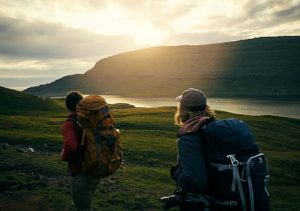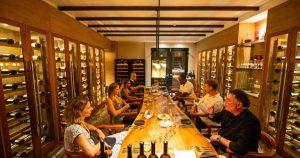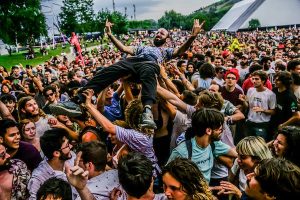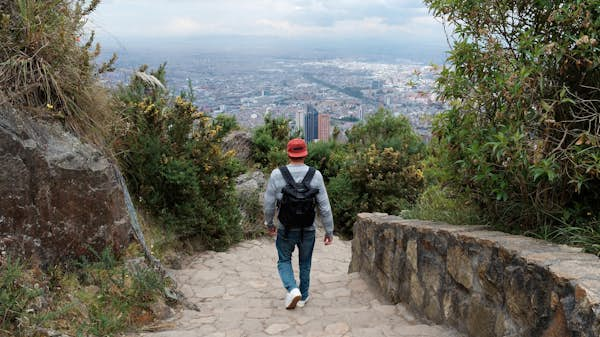
Fear not, financially challenged traveler, Bogotá has a bounty of free and economical things to do if you know where to look. Public transportation is cheap and much of the art and entertainment requires neither a ticket nor a tuxedo – it’s played out on the street.
There’s also a wide network of funky, reasonably priced hostels, many of which offer private rooms. The downtown Candelaria neighborhood – an ideal location due to its proximity to most of the city’s historic sights and nightlife – has an excellent selection, the bulk of them housed in buildings with shady patios, wooden balconies, and a few shoots of greenery. If you’re stuck for choice, look no further than the Cranky Croc, a boutique-standard hostel with gorgeous common areas, slick dorms and fancy new private “pods.”
Here are some top things to do for free in the Colombian capital.
Squeeze every moment out of your next vacation with tips and tricks from Lonely Planet in our weekly newsletter delivered to your inbox.  Mercado de las Pulgas, held every Sunday, has a great atmosphere © OSTILL is Franck Camhi / Shutterstock
Mercado de las Pulgas, held every Sunday, has a great atmosphere © OSTILL is Franck Camhi / Shutterstock
1. Be just looking and not buying at Mercado de las Pulgas
Of Bogotá’s numerous flea markets, this Sunday affair in the northern neighborhood of Usaquén is undoubtedly the best. “Flea market” is a bit of a misnomer. Not everything sold at Las Pulgas’ various stalls is secondhand with items running the gamut from handmade jewelry to figurines crafted from old Venezuelan bank notes. Even if you’re not buying, it’s worth dropping by to savor the bustling weekend atmosphere amplified by the Ciclovia (you can cycle all the way from Candelaria). Many Bogotanos decamp here for Sunday brunch.
Planning tip: The market is adjacent to the Plaza Central de Usaquén and takes place every Sunday between 9am and 5pm.
2. Rent two wheels at the Ciclovia
The Ciclovia is the genius idea first hatched in 1974 which, for one day of the week, transforms Bogotá from a snarling knot of traffic jams into a bona fide biker’s paradise.
Every Sunday between 7am and 2pm, 127km (79 miles) of the city’s streets are given over exclusively to cyclists, runners, walkers, rollerbladers and any other car-less wanderer. Over 1.5 million people regularly take part, meaning the atmosphere is high-spirited and festive with streetside stalls, free outdoor exercise classes, bike repair stations (also free) and spontaneous entertainment.
Planning tip: Taking part will cost you the price of a bike rental, or absolutely nothing if you bring your own. You can rent bikes from Bogotá Bike Tours in Candelaria.
3. Listen to storytellers in Plazoleta del Chorro de Quevedo
Bogotá’s most atmospheric square is smaller, grittier, and more charismatic than the more monumental Plaza de Bolívar. Plonk down on the steps of the whitewashed San Miguel del Príncipe hermitage or grab a pew at one of the bars and cafes opposite and you won’t have to wait long for something entertaining to happen: a circle of hacky-sack players, a roving musician or two, a group of local boho students comparing tattoos. On Friday afternoons at around 5pm, Spanish storytelling sessions convene outside the church.
Planning tip: Come back in the evening when young people pile in and out of the bars that speckle the narrow alleyways nearby.
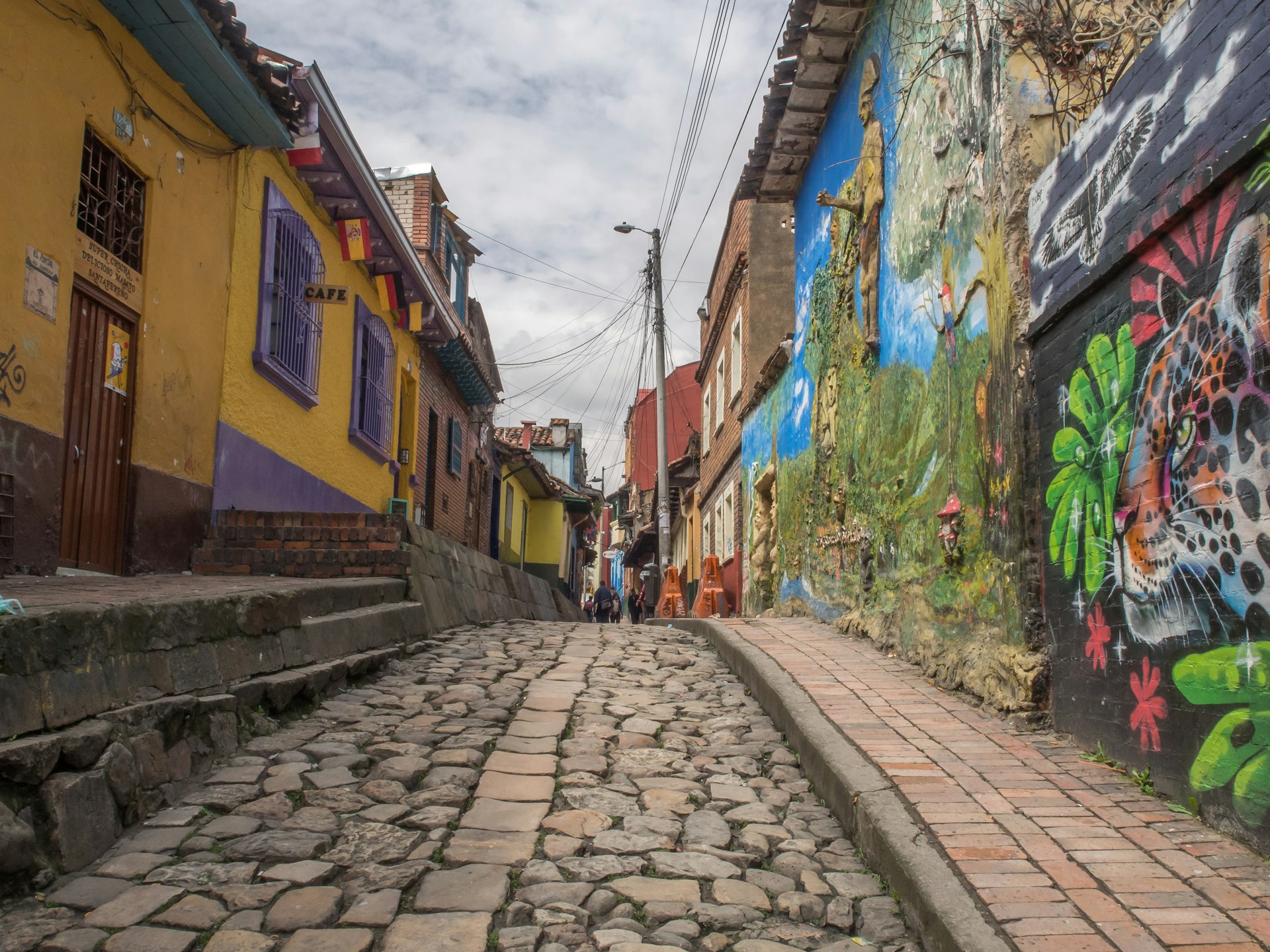 Keep an eye out for murals on the walls of practically every street in Bogotá © Nowaczyk / Shutterstock
Keep an eye out for murals on the walls of practically every street in Bogotá © Nowaczyk / Shutterstock
4. Absorb the street art found everywhere
Bogotá is one of the most graffitied cities in the Americas and there’s barely a street or thoroughfare in the downtown districts that doesn’t sport at least one tag, stencil or mural. In more recent times, the city has even created an official “Distrito Graffiti” near Puente Aranda where a collection of utilitarian warehouses has been given over to talented local artists.
It’s relatively easy to wander around on your own and absorb the murals (Candelaria’s Plazoeta del Chorro de Quevedo is a good place to start) but, for a fuller understanding of the best works and the artists behind them, join a free graffiti tour.
Planning tip: Tours set off twice daily from the Parque de los Periodistas. Look for the person with the blue umbrella. The tours last around two hours and tips are appreciated. Online reservations are encouraged.
5. Climb the steep path to Cerro de Monserrate
If you can forsake the cable car and funicular train for a steep paved path to the summit, a day out on Cerro de Monserrate can be completely free of charge – except for lunch and the copious energy drinks and cups of coffee you may need to fuel your ascent.
The winding path to the top of the city’s sentinel mountain snakes upward for 2.5km (1.5 miles) climbing 500 vertical meters. It delivers exhausted hikers to a 3125m-high (10,252ft) hilltop complex anchored by a basilica and ringed by various trails, food outlets and extravagant viewpoints.
Planning tip: The path is open 5am until 1pm. Most locals start early. If you want to stay on top until later in the day, the cable car is open until 11:30pm (5:30pm Sunday).
6. Dip into the churches of La Séptima
Bogotá’s main drag, Carrera 7 (colloquially known as La Séptima), is punctuated by a string of free-to-enter churches that hide copious riches behind their sometimes-austere facades.
The Catedral Primada, the city’s main church on Plaza de Bolívar, is more impressive for its size than its inner decor. Among its interior draws is the tomb of Gonzalo Jiménez de Quesada, who founded modern Bogotá in 1538. More elaborate on the inside, the Iglesia de San Francisco, the city’s oldest church, is stuffed with a dazzling array of gold-leaf altarpieces, ornate pews, and mysterious spiritual energy. Next door, the Iglesia de la Veracruz is home to many important tombs, while the Iglesia La Tercera sports walls lined with mini wooden altars.
Planning tip: Come to La Séptima on a Sunday for Mass and you can peruse the stalls of the street’s flea market afterwards.
 Tour the collections of Museo Botero and neighboring Museo de Arte Miguel Urrutia for free © Simon Mayer / Shutterstock
Tour the collections of Museo Botero and neighboring Museo de Arte Miguel Urrutia for free © Simon Mayer / Shutterstock
7. View rotund figures at the Museo Botero
Part of a complex of art museums belonging to the Banco de la República, the Museo Botero is filled with the instantly recognizable works of Colombia’s greatest living painter, Fernando Botero. Mixing his distinctive paintings of cartoonish, large-girthed subjects with items donated from his private collection (including Picasso, Klimt and Matisse), it is one of the finest art museums in South America. Astonishingly, the whole feast is free of charge.
Planning tip: Reserve time for the Museo de Arte Miguel Urrutia dedicated to Colombian and Latin American art on the same complex (also free to visit).
8. See gold for free on Sundays at the Museo del Oro
Bogota’s headline sight, the dazzling Museo del Oro, is arguably the world’s finest gold museum. From Tuesday to Saturday, it charges for admission, but on Sunday entry is free. The caveat? Locals have long cottoned on to this fact so be prepared for long lines and plenty of company as you roam the exhibits.
Planning tip: Arrive at 10am on Sundays to avoid the longest queues.
9. Spend an afternoon wandering the San Felipe Art District
A work in progress, San Felipe is Bogotá’s evolving art district, a one-time hub of auto shops and residential houses that, since the mid-2010s, has acquired a more creative veneer. Come here to inspect a fertile mix of galleries, workshops, cafes, bars, artisanal ice-cream makers, bookstores and tertulias (literary gathering places). In the past few years, streets have been traffic-calmed and prominent murals and sculptures have given the neighborhood a colorful visual appeal.
Planning tip: Of the 20 or so galleries, the majority are low-key free-to-enter places where you can meet and chat with the owner-artists. The district is centered around a park at the nexus of Calle 75 and Carrera 22.

